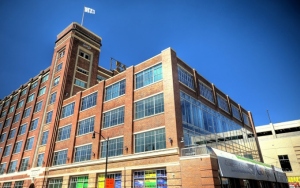It was in the summer of 2001, and my third startup had just driven off a figurative cliff. That’s a story in and of itself, but it doesn’t so much involve Google t-shirts, so I’ll save it for later. I was staring blankly into the monitor at my desk in our little second-story office on the corner of Craig and Henry in Pittsburgh, wondering what the hell I was going to do next.
I’d spent some time trying to compose appropriately-worded email to my old manager, and eventually settled on the brief and cryptic query: Any chance you’ve got a couple of minutes to offer some career advice?
My phone rang less than a minute after I hit “Send”:
“So, Pablo – ridden another one down into a smoking crater, have you?”
Peter, I already knew, didn’t tend to waste time beating around the bush when there was a point to be made.
I’d met Peter six years earlier in Cambridge. I’d wrung about as much time as I could out of the MIT postdoc Mike Jordan offered me, and I had continued to come up skunked on academic offers. Mike was being generous to a fault, but it was time for me to leave the nest. My officemate Satinder mentioned that some British company across the street was trying to create a “world-class machine learning group” – and had tasked Berkeley star Peter Norvig to staff it.
Peter lobbed an slow ball over the plate for my interview question, and a few weeks later Satinder and I hauled our books and office decorations up to the 7th floor of One Cambridge Center to join Steve Rowley as inaugural East Coast members of Harlequin Ltd’s Adaptive Systems Group.
Most of the rest of the group was out in California. Steve kept getting pulled off to non-ASG projects, so once it became clear that Satinder was preparing to depart for academia, Peter urged me to consider moving west to join him in Menlo Park. Much as we loved Cambridge, moving was the right thing to do, so we packed up the figurative station wagon and headed west to the land of opportunity.
I don’t remember how quickly it happened, but it felt like we were still unpacking boxes when Peter asked if I could join him in his office for one of those “and please close the door” conversations. It was, he explained, kind of awkward, but he’d been given an offer he couldn’t refuse. It was 1996, the internet was exploding, and some company with an unpronounceable name had offered him a ridiculous sum to help them dominate web commerce. Which wasn’t even a thing back then, but when he told me the details of the offer, I agreed that only a fool would say no.
We stayed in touch through our subsequent transitions. Peter’s company was bought by Amazon and, when that stopped being fun he joined NASA as the head of Computational Sciences at Ames. I leaped clear of the wreckage just as Harlequin imploded and found myself in Pittsburgh, living in Mr. Rogers’ Neighborhood and working for the awkwardly-named Justsystem Pittsburgh Research Center. That imploded too when Microsoft ate our sponsor’s lunch and I joined yet another startup. Burning Glass was a better run, but that was a different t-shirt and a different story. And when the bottom dropped out there, I found myself on the phone with Peter.
He’d just left NASA to join this company I’d heard of. I’d been using Google since it was a google.stanford.edu, but it wasn’t clear to me how a search engine could be a company. I mean, we’d already been through the internet bubble with social networks for fish, and the one thing we learned was that a cool idea without a business model was not a cool idea.
Peter thought I ought to give Google a look. Sure, I said. But first tell me how they make money. Showing ads? You’re kidding, right? No – really, Peter insisted, I think you should come out and have a look.
 But we’d already fallen in love with Pittsburgh. It took a lot of recruiting to get us there in the first place, but once we put down roots we knew – we just knew – that it was where we were going to raise our family and grow old.
But we’d already fallen in love with Pittsburgh. It took a lot of recruiting to get us there in the first place, but once we put down roots we knew – we just knew – that it was where we were going to raise our family and grow old.
That Steel Town image everyone totes around from the 70’s is as outdated as disco and eight-track cassettes. The steel mills had monopolized the city’s extensive waterfronts ,and when they closed, the gradual brown-field reclamation transformed these spaces into beautiful parks and promenades. All that remained of Pittsburgh’s smokestack legacy were the dozen iconic steel bridges that spanned the city’s three rivers. Each one was different, each had its own personality, and each had its own story of who and what and which little microcosms it connected across the gently flowing Allegheny, Monongahela and Ohio.
 And we lived, as I said, in Mr. Rogers’ Neighborhood: his house was about four blocks away and his daughter lived halfway down the block on our street. He was the real thing, and his iconic personality perfectly captured the ethos of the Malvern Avenue: Rope swings hanging from the big pin oak and open invitations to pick mulberries from Lucille’s tree. Kids tumbling from one yard to the next and ending up in some family’s kitchen for lunch. Sidewalk chats with strangers that end up as front porch coffee. Yellow slicker raincoats gathered on our front porch for shelter on school mornings when it rained; we lived on the corner – “the bus stop house,” we told strangers – and they always knew what we meant.
And we lived, as I said, in Mr. Rogers’ Neighborhood: his house was about four blocks away and his daughter lived halfway down the block on our street. He was the real thing, and his iconic personality perfectly captured the ethos of the Malvern Avenue: Rope swings hanging from the big pin oak and open invitations to pick mulberries from Lucille’s tree. Kids tumbling from one yard to the next and ending up in some family’s kitchen for lunch. Sidewalk chats with strangers that end up as front porch coffee. Yellow slicker raincoats gathered on our front porch for shelter on school mornings when it rained; we lived on the corner – “the bus stop house,” we told strangers – and they always knew what we meant.
So. Leave our home in Pittsburgh? Besides, put yourself in my shoes: I still had scorch marks from the last time I moved out to California once to work with this guy. I’d seen that movie once, and I didn’t need to see it again.
“Sorry, Peter. Tell you what: if Google is really going to be successful, if they’re really going to grow like you say, I’ll join when they open a Pittsburgh office.”
This was before I had come to appreciate that fact that Peter was one of three people in my life (along with my old housemate Tiron and, obviously, my wife) who were never wrong. Never.
“Oh, I think it’ll happen, Pablo. But I think, if you wait until it does, you’ll regret it.”
But Pittsburgh had captured my heart. It was perhaps the most human and humane place I’d ever lived. I walked to work through the towering old trees of Schenley Park. At lunch I could stroll through the awe-inspiring Carnegie Museums just down the street. And unlike the sterile and combative environment I felt when trying to build academic connections at Stanford, CMU welcomed me with open arms. Department Chair Takeo Kanade offered me an adjunct position, collaborators and even office space for the asking. I thanked Peter for his interest in my well-being, but said we were going to stick it out where we were.
My fourth startup was a fabulous, heady ride. But that too is another t-shirt and another story, and by the time it cratered, we were out of options: we’d burnt through our savings and, as Devon put it, it was time to get a “real job.” I called Peter and asked if Google was still an option.
Four months later, on October 24th, 2002, I reported for work in Mountain View (okay, there’s a story there, too, about the inimitable Carrie Farrell, about how she and Peter tag-teamed me and Devon to seal the deal. Every few months I still send Carrie email out of the blue thanking her for being so persistent.)
It was 2006 when Google finally decided to open a Pittsburgh office, and when they did, they asked me to help them convince Andrew Moore of CMU to be its first Engineering Director. Aside from being the best all-around computer scientist I’ve ever met, and one of the best teachers I’ve ever worked with, Andrew is also one of the most generous people I’ve known. When I was struggling between startups, Andrew found projects I could help with in his lab. He introduced me to potential collaborators and connected me with consulting gigs to help us stay afloat.
Andrew embodied everything that I loved about CMU, so I was understandably ambivalent about trying to convince him to leave it and join the burgeoning behemoth Google was becoming. But, I rationalized, Andrew had the potential to change the world (ask him, some time, about when he had to brief President Bush on KD-tree approximations). And what better platform from which to do it than as a director at Google?
 The new office in Bakery Square, like many in Pittsburgh, is housed in a funky old renovated red-brick industrial building. This one happened to be the old Nabisco factory, and stepping inside felt like a homecoming. I couldn’t get five steps without another familiar face popping up from behind a cubicle wall saying they thought they heard my voice, and it was great to see me and when were we going to be moving “back home” to Pittsburgh?
The new office in Bakery Square, like many in Pittsburgh, is housed in a funky old renovated red-brick industrial building. This one happened to be the old Nabisco factory, and stepping inside felt like a homecoming. I couldn’t get five steps without another familiar face popping up from behind a cubicle wall saying they thought they heard my voice, and it was great to see me and when were we going to be moving “back home” to Pittsburgh?
Honestly, we thought about it. It took a few years out here in Palo Alto making friends, getting the kids settled in school and succumbing to the seductive climate before we were really sure that we weren’t going back. It’s been 14 years now, and Pittsburgh still feels like that old flame that I get a little glossy-eyed over whenever I see those bridges.
But I still make a point of thanking Peter every time I see him for saving me from that regret.



I am a veterinarian, working near the Pittsburgh office of Google. One of my clients came in wearing the black t-shirt shirt yesterday. So, what did I do at home? Googled the shirt, and tried to figure out how to get my hands on one. Love that image!!
LikeLiked by 1 person
Thanks for the note! Hmmm – it’s been a few years, but there’s always been a bit of an informal t-shirt trade. I’ll wager that if you ask the next Googler who comes in if he/she knows a way to get their hands on one, they might be able to come up with something. Especially for their veterinarian!
LikeLike